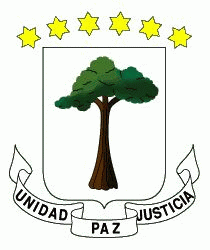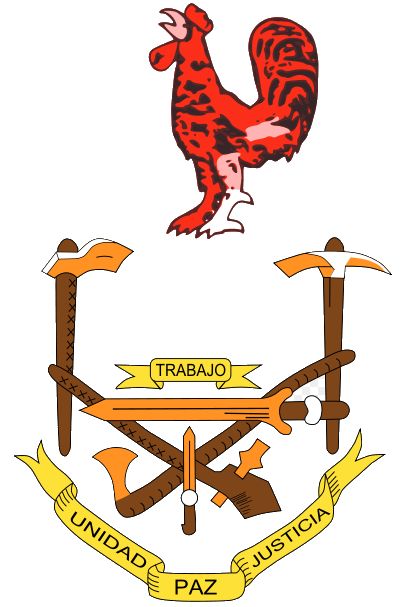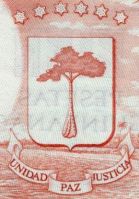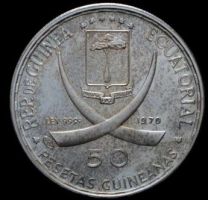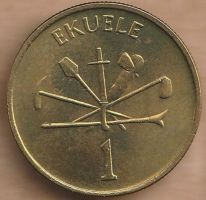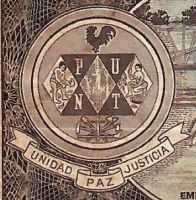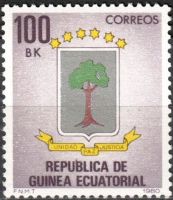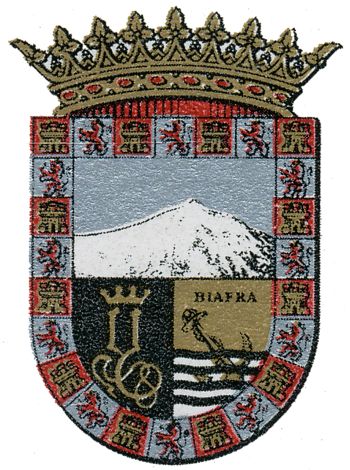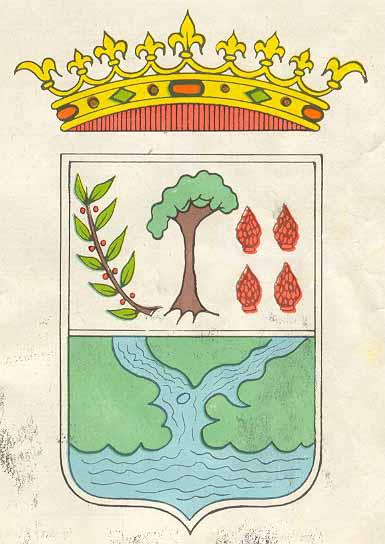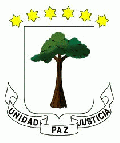National Arms of Equatorial Guinea: Difference between revisions
Knorrepoes (talk | contribs) No edit summary |
Knorrepoes (talk | contribs) m (Text replacement - "===Official blazon===↵↵===Origin/meaning===" to "{| class="wikitable" |+Official blazon |- |'''English''' | blazon wanted |} ===Origin/meaning===") |
||
| (17 intermediate revisions by the same user not shown) | |||
| Line 1: | Line 1: | ||
'''NATIONAL COAT OF ARMS OF EQUATORIAL GUINEA | |||
[[File:Equatorial Guinea.gif|center|Coat of arms (crest) of {{PAGENAME}}]] | |||
{| class="wikitable" | |||
|+Official blazon | |||
|- | |||
|'''English''' | |||
| blazon wanted | |||
|} | |||
===Origin/meaning=== | |||
The arms were adopted on August 21, 1979. | The arms were adopted on August 21, 1979. | ||
The arms show a silk cotton tree, or so-called "God tree". This | The arms show a silk cotton tree, or so-called "God tree". This tree is of local historical interest, as under such a tree the Spanish signed a treaty with the local chieftain, effectively making the area a Spanish territory. | ||
The six six-pointed stars above the shield represent the mainland and the five main islands in the country. | The six six-pointed stars above the shield represent the mainland and the five main islands in the country. | ||
| Line 20: | Line 21: | ||
The arms were initially adopted in 1968, but during the rule of Francisco Nguema (1972-79) the arms were replaced by a logo, see below. | The arms were initially adopted in 1968, but during the rule of Francisco Nguema (1972-79) the arms were replaced by a logo, see below. | ||
[[File:Equatorial Guinea logo. | [[File:Equatorial Guinea logo.jpg|center]] | ||
===Image gallery=== | |||
<gallery widths=250px heights=200px perrow=0> | |||
File:gqc4.jpg|alt=Arms (crest) of |The arms on a bank note 1969 | |||
File:gqc5.jpg|alt=Arms (crest) of |The arms on a coin from 1970 | |||
File:gqc1.jpg|alt=Arms (crest) of |Coin from 1975 (partial national emblem) | |||
File:gqc2.jpg|alt=Arms (crest) of |Coin from 1975 (partial national emblem) | |||
File:gqs1.jpg|alt=Arms (crest) of |The arms on a stamp from 1975 | |||
File:gqc3.jpg|alt=Arms (crest) of |The national emblem on a bank note 1976 | |||
File:gqc6.jpg|alt=Arms (crest) of |The arms on a bank note 1979 | |||
File:gqs2.jpg|alt=Arms (crest) of |The arms on a stamp from 1980 | |||
</gallery> | |||
==Colonial arms== | ==Colonial arms== | ||
| Line 33: | Line 46: | ||
The arms show in the upper half the island itself. The lower half shows the monogramme of King Charles II. The lower left quarter shows an anchor in the waves and the name Biafra. The meaning thereof I do not know. | The arms show in the upper half the island itself. The lower half shows the monogramme of King Charles II. The lower left quarter shows an anchor in the waves and the name Biafra. The meaning thereof I do not know. | ||
The | The bordure is the Royal Bordure of Castille and Leon. | ||
===Río Muni=== | ===Río Muni=== | ||
[[File:riomuni.jpg|center]] | [[File:riomuni.jpg|center]] | ||
Río Muni was also ceded to the Spanish by the Portuguese in 1778. The arms of the province show the same tree and were the | Río Muni was also ceded to the Spanish by the Portuguese in 1778. The arms of the province show the same tree and were the base of the present national arms. | ||
Another version of the arms is shown below : | |||
[[File:riomuni2.jpg|center]] | |||
In these arms the tre eis combined with the main crops and the geographical situation of the colony. | |||
[[Literature]] : - | [[Literature]] : - | ||
{{gq}} | |||
{{media}} | |||
[[Category:Equatorial Guinea]] | [[Category:Equatorial Guinea]] | ||
[[Category:National Arms]] | [[Category:National Arms]] | ||
[[Category:Granted 1979]] | [[Category:Granted 1979]] | ||
Latest revision as of 14:07, 29 January 2024
NATIONAL COAT OF ARMS OF EQUATORIAL GUINEA
| English | blazon wanted |
Origin/meaning
The arms were adopted on August 21, 1979.
The arms show a silk cotton tree, or so-called "God tree". This tree is of local historical interest, as under such a tree the Spanish signed a treaty with the local chieftain, effectively making the area a Spanish territory.
The six six-pointed stars above the shield represent the mainland and the five main islands in the country.
The motto Unidad, Paz, Justicia ("Unity, Peace, Justice").
The arms were initially adopted in 1968, but during the rule of Francisco Nguema (1972-79) the arms were replaced by a logo, see below.
Image gallery
Colonial arms
Equatorial Guinea was a Spanish colony consisting of two parts, the island of Fernando Poo (Bioko) and the continental colony of Rio Muni. In 1959 the two colonies were combined to Spanish Guinea, which in 1968 became Equatorial Guinea.
Fernando Poo
In 1472, the Portuguese navigator Fernão do Pó was the first European to visit the island. He named it Formosa Flora ('Beautiful Flower'), but in 1494 it was renamed after its discoverer. The Portugiese settled on the island, but were replaced by the Dutch from 1642-1648. In 1778 the island was ceded to the Spanish King Charles II. The Spanish did not establish strong rule on the island, and the British took over the island on a lease from 1827-1843. In 1843 the Spanish established full control.
The arms show in the upper half the island itself. The lower half shows the monogramme of King Charles II. The lower left quarter shows an anchor in the waves and the name Biafra. The meaning thereof I do not know.
The bordure is the Royal Bordure of Castille and Leon.
Río Muni
Río Muni was also ceded to the Spanish by the Portuguese in 1778. The arms of the province show the same tree and were the base of the present national arms.
Another version of the arms is shown below :
In these arms the tre eis combined with the main crops and the geographical situation of the colony.
Literature : -
Equatorial Guinea heraldry portal
This page is part of the Equatorial Guinea heraldry portal |
Heraldry of the World |
|
Civic heraldry:
|
Other heraldry: |
Contact and Support
Partners:
Your logo here ?
Contact us
© since 1995, Heraldry of the World, Ralf Hartemink 
Index of the site
